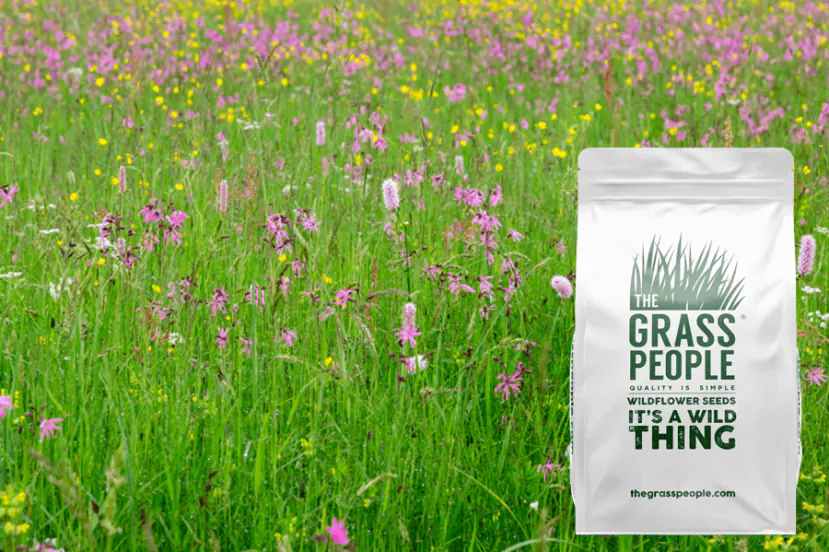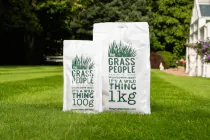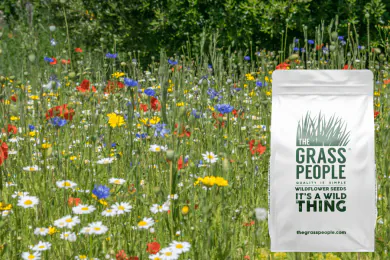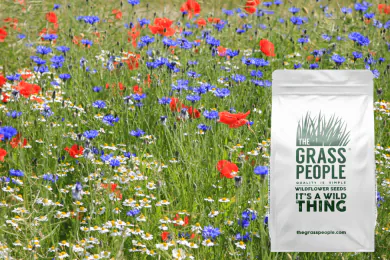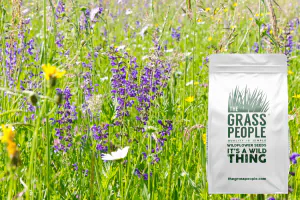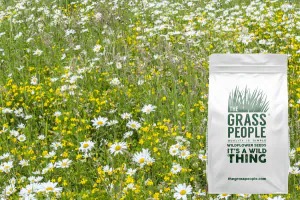Heavy Clay Soils Wildflowers
- Deep rooting wildflowers hold their own in heavy clay soils
- Perennials provide a year on year range of species variety and colour
- Makes problematic areas part of the garden again
Please refresh the page in 1 minute to see the next delivery time.
How much do I need?
Simply enter the length and width of the area, to calculate how much you need.
Product Description
Our experts are at it again! We believe wildflowers should be available to everyone, that’s why we created this mix for those who suffer from heavy clay soils and want to introduce wildflowers to these particularly problematic areas. Our Heavy Clay Soils mix is a blend specifically made up of deep rooting wildflowers that will hold their own in heavy clay soils and can also withstand drought conditions when clay soils dry up in hot weather. The accompanying grasses in this mix help to stabilise the structure of the wildflowers by creating a nursery for the perennial flora to thrive in. This mix also provides a food source for bees and pollinators through its selection of RHS Plants for Pollinators wildflowers.
Mixture Breakdown
May – September
What colour is it?White / Yellow
Annual or Perennial?Perennial
Latin NameLeucanthemum vulgare
DescriptionImagine the daisy chain these would make! Oxeye Daisy is the largest member of the daisy family and its almost flat surface makes the perfect landing pad for bees and pollinators.
April - July
What colour is it?Yellow
Annual or Perennial?Annual
Latin NameMedicago lupulina
DescriptionDespite its name, Black Medick is actually a yellow wildflower that resembles a clover. Just like a clover, it is exceptionally good at attracting bees and pollinators and due to its 'sprawling' ability, is particularly good at thriving in clay soils!
January – December
What colour is it?White / Brown
Annual or Perennial?Perennial
Latin NamePlantago lanceolata
DescriptionRibwort Plantain although not the brightest wildflower, certainly adds a natural diversity to your wildflower meadow. Its tiny white buds provide food for bees and pollinators whilst its seeds are great for Goldfinches.
June – September
What colour is it?Yellow
Annual or Perennial?Perennial
Latin NameAnthyllis vulneraria
DescriptionKidney Vetch is a bright yellow budding wildflower that sometimes gets the name Woundwort. Although this isn't the nicest nickname, it was once used for treating ailments, and of course - wounds.
July - September
What colour is it?Purple
Annual or Perennial?Perennial
Latin NameCentaurea Scabiosa
DescriptionGreater Knapweed is the larger relative of Common Knapweed, with distinctly larger flower heads. Just like its smaller sibling, Greater Knapweed is a vital source of food for bees and pollinators.
May - October
What colour is it?White
Annual or Perennial?Perennial
Latin NameSilene latifolia
DescriptionThe white sibling of Red Campion, this wildflower still holds it on with its lengthy rayed petals. At night time it is said to produce a clover scent that is attractive to many bees and pollinators.
June - September
What colour is it?Yellow
Annual or Perennial?Perennial
Latin NameGalium verum
DescriptionLady's Bedstraw used to be used in bedding due to its soft and springy texture! This is definitely a wildflower you'll want in your meadow... when you walk past it, it smells of honey.
June - September
What colour is it?White
Annual or Perennial?Perennial
Latin NameTrifolium repens
DescriptionWhite Clover is a great source of food for bees and pollinators who can enjoy its nectar from a slightly shorter height. Its dome flowers create a pretty globe of white blooms.
May – September
What colour is it?Pink / Green
Annual or Perennial?Annual
Latin NameSanguisorba minor
DescriptionA perennial wildflower with toothed leaves and pink flowers, its leaves when crushed smell like cucumber and used to be used in salads!
June - October
What colour is it?Purple
Annual or Perennial?Perennial
Latin NameStachys officinalis
DescriptionBetony is related to the nettle family and produces bright magenta blooms. It is thought that when you see Betony, it is an indication that ancient woodlands are near.
June - September
What colour is it?Green
Annual or Perennial?Perennial
Latin NameReseda luteola
DescriptionWeld sprouts teeny tiny cream buds and has a tendency to appear near foot paths. Although it may not have as much flora as other wildflowers, the spikes on its small flowers are an excellent source of pollen and nectar for butterflies and bees.
June - September
What colour is it?White
Annual or Perennial?Perennial
Latin NameDaucus carota
DescriptionPart of the carrot family, Wild Carrot smells like carrots but is not the kind of one you would want to eat. Its low nutrient and drought tolerant abilities make it ideal for sandy soils.
May – September
What colour is it?Purple / Pink
Annual or Perennial?Perennial
Latin NameTrifolium pratense
DescriptionRed Clover is a popular perennial that despite its name, is actually purple! It's dome-shaped flowers are relatively low-growing which makes it the perfect fodder food for livestock but is also a fan favourite of weary bees who need a feed a little closer to the ground.
June - September
What colour is it?White
Annual or Perennial?Perennial
Latin NameFilipendula ulmaria
DescriptionMeadow Sweet produces frothy clusters of sweet-smelling white flowers. It can be found and favours woodland shaded areas with damp soil
May - September
What colour is it?Yellow
Annual or Perennial?Annual
Latin NameRhinanthus minor
DescriptionYellow Rattle can be used in existing meadows where meadow grasses have taken over. It helps to weaken these grasses to allow other wildflowers to flourish, and does this by locking its roots to those of the grasses, and therefore lessens their abundance.
June – August
What colour is it?Red / Black
Annual or Perennial?Annual
Latin NamePapaver rhoeas
DescriptionCorn Poppy is a vibrant and bright addition to any meadow and easily recognisable and identifiable throughout the UK. Of course it has meaning for many, and also adds a colourful pop to any wildflower plot
This is a grass seed and typically germinates at temperatures of 8 -10 degrees
What colour is it?Green / Beige
Annual or Perennial?Perennial
Latin NameCynosurus cristatus
DescriptionCrested Dogstail is a grass that performs in most soil types
This is a grass seed and typically germinates at temperatures of 8 -10 degrees
What colour is it?Green / Beige
Annual or Perennial?Perennial
Latin NameFestuca arundinacea
DescriptionTall Fescue is a grass that performs in most soil types
This is a grass seed and typically germinates at temperatures of 8 -10 degrees
What colour is it?Green / Beige
Annual or Perennial?Perennial
Latin NameFestuca ovina
DescriptionSheeps Fescue is a grass that performs in most soil types
This is a grass seed and typically germinates at temperatures of 8 -10 degrees
What colour is it?Green / Beige
Annual or Perennial?Perennial
Latin NameFestuca rubra ssp. Commutata
DescriptionChewing's Fescue is a grass that performs in most soil types
Usage Guide
● Remove any existing grass, plants or flora from the area where you plan to sow your wildflower seed. Failure to do this will produce poor results
● Further remove the top 5-10cm to reduce soil fertility
● Allow the area to cultivate for several weeks, and remove any weeds that may pop in the area during this time
● Do not be tempted to add top soil, compost or fertiliser to the area - wildflowers prefer low nutrient conditions
● After the cultivation period ensure to remove stones or any other debris and rake the area to create a fine, friable and level seedbed
● Scatter the seed at a rate of 5g per m2
● Rake the seed so that it is in amongst the soil
● Water the just-sown wildflower seed well
● If sowing in drought conditions, water as required to keep the area moist in the first 6 weeks after sowing
Read our full guide on how to manage your wildflower meadow here.
| Sowing Rate | 5g per m2 |
| When | For best results sow in September |
Aftercare
End of year cut:
- We recommend doing this essential end-of-year cut in autumn.
- Your wildflowers are ready for their first cut when they have grown to 7cm and have gone to seedhead.
- This cut can be done using your lawn mower at its highest setting or using a strimmer.
Early spring cut:
- An early spring cut is ideal when your wildflowers are well-established.
- This early spring cut trims back meadow grasses and helps increase the density of the wildflowers.
- This cut also encourages wildflowers to grow better later that season.
- Cut before the end of April, or you may stunt their growth, and they could skip blooming that year.
Summer cut (optional):
- A cut between June and August can encourage the growth of wildflowers later in the season.
- Cut back to 7cm tall and remove the cuttings.
- This optional cut encourages new wildflowers to grow and flourish.
What to do with the cuttings (if you have annual wildflowers in the mix):
In dry conditions:
- If conditions will be dry for 5-7 days, you can let the cuttings lie on the ground so the seeds drop.
- Walk over, use a roller or shake the seedheads to encourage the seeds to fall and grow next season.
- Then remove the plant cuttings after a week and dispose of them in your garden waste bin.
In wet conditions:
- Lift the clippings if rainfall is forecast, and manually free up the seeds by crushing the seedhead to collect the seeds for replanting.
- When dry conditions return, scatter the seeds across your wildflower area.
- Alternatively, you can store your collected wildflower seeds in an envelope and replant them later.
For further reading, check out our guide on when and how often to cut a wildflower meadow.
The above photo depicts the variety of species you should expect to see in your wildflower display. Please note that certain species within this mix and all our wildflower mixes may become more abundant than others, and this varies based on the conditions in which they are sown. Taking this into consideration, your wildflower meadow will evolve and adapt year after year and change in appearance as certain species may become more dominant than others.
Product Questions
Product Questions
If you would like to email us some pictures of the area, we can take a closer look and advise on best to proceed. You can email them to [email protected]
The soil in the garden is also very claggy clay and very hard.
I didn’t mow it this year and now have tall grass probably about a foot high but no flowers.
I want to try turning it into a wildflower area.
I see you have a mix for shade and a mix for clay but I have both. What do you advise to get this going please?
I would recommend our Heavy Clay Soils Wildflowers. This is a mix of wildflower species that have deep rooting properties and penetrate heavy clay soils and are also drought-tolerant, making them ideal for such areas. This is a mix of annuals, perennials and grasses.
If this area is very shady, you could sow a mix of Heavy Clay Soil Wildflowers and Shaded Area Wildflowers. Shaded Area Wildflowers consist of annual and perennial wildflowers and grasses that tolerate damp and shaded areas.
I have also included our guide on how to prep and sow a wildflower meadow:
1. Remove any existing grass, plants or flora from the area where you plan to sow your wildflower seed. Failure to do this will produce poor results
2. Further, remove the top 5-10cm to reduce soil fertility
3. Allow the area to cultivate for several weeks, and remove any weeds that may pop in the area during this time
4. Do not be tempted to add topsoil, compost or fertiliser to the area - wildflowers prefer low nutrient conditions
5. After the cultivation, period ensure to remove stones or any other debris and rake the area to create a fine, friable and level seedbed
6. Scatter the seed at a rate of 5g per m2
7. Rake the seed so that it is in amongst the soil
8. Water the just-sown wildflower seed well
If sowing in drought conditions, water is required to keep the area moist in the first 6 weeks after sowing.
The safeness and suitability of sowing wildflowers in reach of animals is an issue, and whether consumption / ingestion of the flowers is of a huge concern.
Wildflowers such as Buttercups and Foxgloves are poisonous to animals and can be to humans and are present in all our wildflower mixes. Each of these wildflowers has minor to moderate toxicity and can prove fatal if consumed / ingested in any amount. Therefore, we would not recommend sowing any of our wildflower seed mixes, or any others, near your children or pets if you have concerns that they would consume them.
Animals have intelligent instincts and by using their scent can work out what is and what isn’t poisonous, so there is low risk of them wanting to snack on your wildflowers. However, if your livestock has a penchant for wolfing down wildflowers or any other garden flora it is best not to put anything in front of them that could potentially harm them.
We have a north facing, clay based garden and I am planning to introduce a meadow area bordering the lawn. I plan to use a turf cutter to clear the meadow strips by the lawn. We like the look of the flowering meadow mix but feel the heavy clay mix may be more suitable. Could we get a 1kg bag of each and mix them for a combined effect?
Rgds - Charlie
Thank you for your enquiry.
We would usually recommend our Heavy Clay Soils Wildflowers, for clay conditions such as this, as it contains a mix of wildflower species that have deep rooting properties and penetrate heavy clay soils and are also drought tolerant, making them ideal for such areas. However you can combine this mix with the flowering meadow mix if you wish, and both mixes should still grow, but for this type of soil condition, Heavy Clay Soils Wildflowers would probably be the best option.
The safeness and suitability of sowing wildflowers in reach of children and pets largely concerns whether consumption / ingestion of the flowers is of a huge concern. Wildflowers such as Buttercups and Foxgloves are poisonous to animals and can be to humans, and are present in all of our wildflower mixes. Each of these wildflowers have minor to moderate toxicity and can prove fatal if consumed / ingested in any amount. Therefore, we would not recommend sowing any of our wildflower seed mixes, or any others, near your children or pets if you have concerns that they would consume them.
Animals have intelligent instincts and by using their scent can work out what is and what isn’t poisonous, so there is low risk of them wanting to snack on your wildflowers. However, if your pet or livestock has a penchant for wolfing down wildflowers or any other garden flora it’s best not to put anything in front of them that could potentially harm them. Likewise, children may have the same curiosity. If you are concerned that your child may try to eat the wildflowers in your garden, then again, we would advise not sowing them.
First, apply a weedkiller to the area prior to sowing and remove as much as possible. You could leave for a week or 2 to see if any return and then remove these manually, this won't be difficult as the roots will be shallow at this stage. Then once established, try to remove weeds as you spot them or treat with a selective herbicide, these can be applied to an existing meadow as they will only treat selected weeds.
At the end season, once the meadow has bloomed, cut back the meadow and remove any cuttings, each year you could add little seed or help the existing flowers self seed. A full, dense meadow will create less room for the weeds. We do have few interesting blogs on the website that you might be interested in.
There are two times in the year that we recommend sowing a meadow, one is spring and the other is autumn. Autumn is an ideal time because the seeds need to undergo the process of stratification (a freeze) to kick start their germination. If you were to sow the seed now, the wildflowers will not bloom until next spring, early in the season. However if there are grass species within the mix you can expect to see these first within weeks of sowing if the temperature is right. Ideally temperatures for germination need to be 8-10 degrees Celsius, if you have these sort of temperatures consistently for 2 weeks then the seeds should germinate. If you feel that the weather is not guaranteed or it is too cold in your part of the country then I would suggest that you delay sowing until Spring. If you decide to wait until next year and sow in the spring then your meadow will flower in the summer.
You are right in looking at our Clay Soils Wildflowers ( https://thegrasspeople.com/heavy-clay-soils-wildflowers ), which are ideal for growing in these conditions.
Clearing the weeds is a great initial step to take; the next steps we advise are as follows:
● Remove the top 5-10cm of soil to reduce soil fertility
● Allow the area to cultivate for several weeks, and remove any weeds that may pop in the area during this time
● Do not be tempted to add topsoil, compost or fertiliser to the area - wildflowers prefer low-nutrient conditions
● After the cultivation period, ensure to remove stones or any other debris and rake the area to create a fine, friable and level seedbed
● Scatter the seed at a rate of 5g per m2
● Rake the seed so that it is in amongst the soil
● Water the just-sown wildflower seed well
● If sowing in drought conditions, water as required to keep the area moist in the first six weeks after sowing
You can read our full guide on how to sow wildflower seed here - https://thegrasspeople.com/sow-wildflower-seed/
